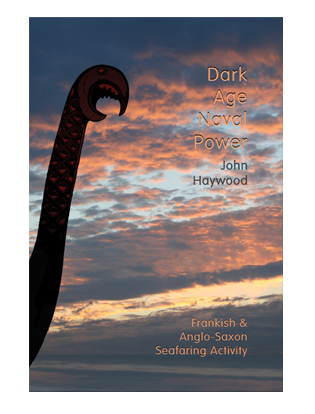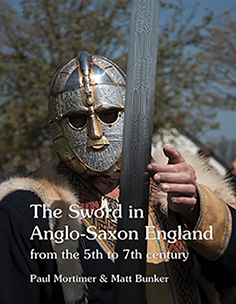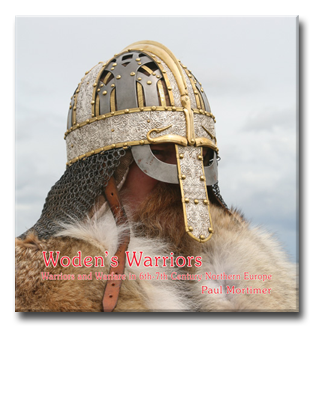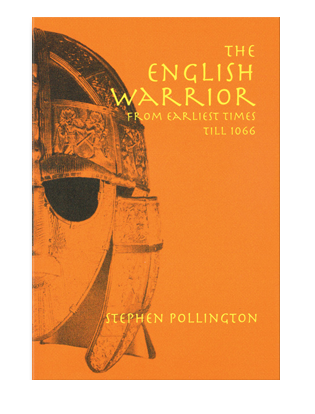|
The Life and Times of
Hengest
Bryan
Evans
Here is the tale of Hengest set
against the end of Roman rule in Britain and the beginning of
the Anglo-Saxon conquest.
The book begins with an overview
of the wider European stage. Then, events in Britain are looked
at through the words of Gildas, Bede, the Anglo-Saxon Chronicle
and Historia Brittonum. What information can be gleaned from them
and how reliable are they? What impact have modern genetic studies
had on our understanding of the age of migration? The main arguments
concerning the extent of Anglo-Saxon migration are conveniently
summarised.
Part two provides a cultural setting for Hengest and includes
information about warcraft and beliefs. An account of early English
poetry outlines of some of the tales that formed part of the matter
of the poet: the tales of Offa of Angeln, Heoden and Hild, Welund,
Waldere.
Part three includes the Finnsburg Fragment, the Anglo-Saxon poem
that tells of Hengest. Using clues from this and other sources
the author has wrought two 'Anglo-Saxon' poems, telling the tale
of Hengest.
Includes 7 maps and 10 drawings by the author.
£14.95 280 pages Approx. 170 x 244mm
- 6¾ x 9½ inches
The Battle of Maldon
Text and Translation
Translated and edited by Bill Griffiths
The Battle of Maldon was fought between
the Englishmen of Essex and Danes in AD 991. The action was captured
in an Anglo-Saxon poem whose vividness and heroic spirit has fascinated
readers and scholars for generations. The Battle of Maldon includes
the source text; edited text; parallel literal translation; verse
translation; notes on pronunciation; review of 103 books and articles.
This new edition includes notes on Old English verse.
* The edited Old English text and parallel literal Modern English
translation is intended to be of help to those learning Old English.
£5·95
Dark Age Naval Power
A re-assessment of Frankish and Anglo-Saxon
seafaring activity.
John Haywood
In the first edition of
this work, published in 1991, John Haywood argued that the capabilities
of the pre-Viking Germanic seafarers had been greatly underestimated.
Since that time, his reassessment of Frankish and Anglo-Saxon
shipbuilding and seafaring has been widely praised and accepted.
‘The book remains a historical study of the first order.
It is required reading for our seminar on medieval seafaring at
Texas A & M University and is essential reading for anyone
interested in the subject.’
F. H. Van Doorninck, The American Neptune
‘The author has done a fine job, and his clear and strongly
put theories will hopefully further the discussion of this important
part of European history.’
Arne Emil Christensen, The International
Journal of Nautical Archaeology
‘Writing a comprehensive history of the clandestine
activities of preliterate Dark Age societies is an ambitious task
and this book is a remarkable achievement.’
Gillian Hutchinson, Mariner’s Mirror
In this second edition, some sections of the
book have been revised and updated to include information gained
from excavations and sea trials with sailing replicas of early
ships. The new evidence lends weight to the author’s argument that
early Germanic shipbuilding and seafaring skills were far more
advanced than previously thought. It also supports the view that
Viking ships and seaborne activities were not as revolutionary as
is commonly
believed.
£16·95 hardback 224 pages
The Sword in
Anglo-Saxon England
from the 5th to 7th century
Paul Mortimer and Matt Bunker
The contributors to this book bring
their practical and academic knowledge to an exploration of new
ideas and information about the making and use of swords in the
early Anglo-Saxon period. They provide an insight to the symbolism
of swords, their decoration and place in society. Other items
carried and worn by warriors are similarly treated.
There is an extensive survey of writings about swords from the
Early Middle Ages, together with discussions on the way swords may
have been used and worn. There is a chapter about the language of
the sword and runic associations. Several modern sword-smiths have
contributed knowledge gained from forging weapons. In addition to
those who have contributed essays, there are many scholars,
smiths, craftspeople, re-enactors and others who have added to the
ideas, theories and discussions presented in this book.
£45
Illustrations: 180 colour. 76 B&W.
Large format approx. 20x25cm -
8 x10 inches. Paperback
Woden's Warriors
Warfare, Beliefs, Arms and Armour in Northern
Europe during the 6-7th Centuries
Paul Mortimer
This book explores some of the ideas and
resources used by warriors in Anglo-Saxon England and Northern
Europe during the 6th and 7th centuries.
This was a time of great change following a period of migration.
Warrior kings and their followers gave expression to their status
and wealth through the creation of embellished war gear made with
great craftsmanship and artistry. It was a time when traditional
beliefs and power structures faced challenges from a centralised
and powerful Church. In the turmoil of the time, traditional ideas
about identity and belief were mingling with new Christian values.
The aim of this book is to provide a glimpse of what it was like
to be part of a warrior society. The author looks in detail at
the weapons and armour used, and the attitudes and beliefs that
inspired the warriors and shaped their societies.
305 black & white and colour illustrations
This title is out of print.
We aim to publish a revised edition in paperback but do not yet
have a date.
The English Warrior from
earliest times till 1066
Anglo-Saxon warriors, weapons and warfare
Stephen Pollington
This important work is not intended to be
a bald listing of the battles and campaigns from the Anglo-Saxon
Chronicle and other sources, but rather it is an attempt to get
below the surface of Anglo-Saxon warriorhood and to investigate
the rites, social attitudes, mentality and mythology of the warfare
of those times.
"An under-the-skin study of the role, rights, duties,
psyche and rituals of the Anglo-Saxon warrior. The author combines
original translations from Norse and Old English primary sources
with archaeological and linguistic evidence for an in-depth look
at the warrior, his weapons, tactics and logistics. A very refreshing,
innovative and well-written piece of scholarship that illuminates
a neglected period of English history."
Time Team Booklists Channel 4 Television
Appendices offer original translations of the three principal
Old English military poems, the battles of Maldon, Finnsburh and
Brunanburh
38 figures and illustrations
£14·95 272 pages
BACK
TO SUBJECT LIST
|





